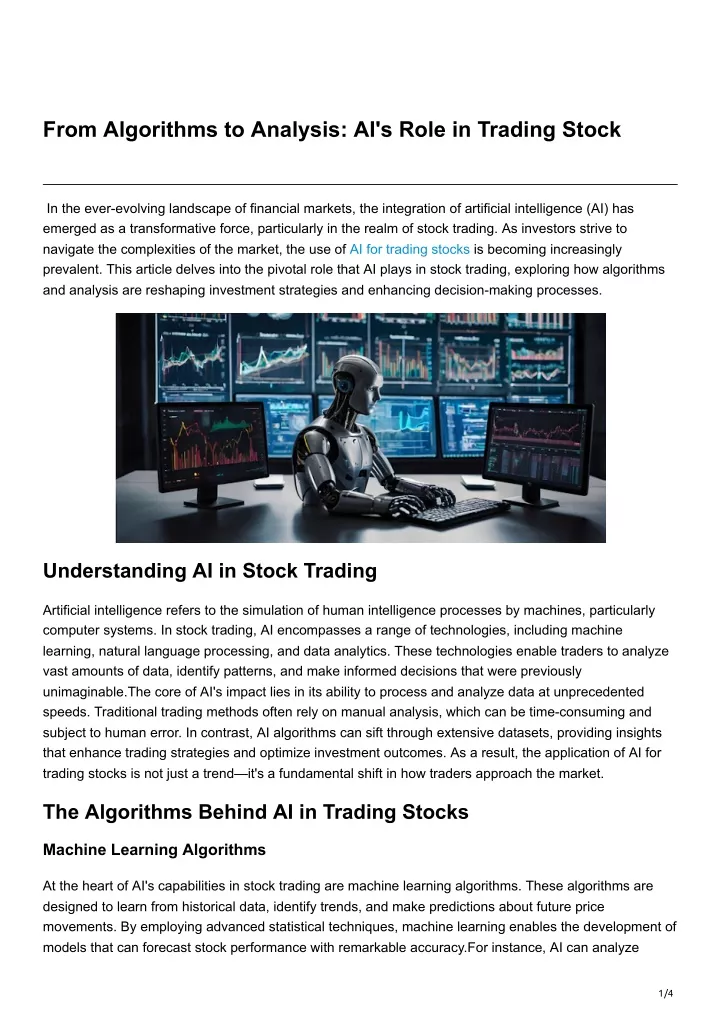20 Handy Ways For Choosing AI Stock Prediction Websites
Top 10 Tips When Evaluating The Cost And Pricing For Ai Stock Predicting/Analyzing PlatformsTo obtain the most value for your money it is essential to evaluate and price AI analysis and stock prediction platforms. Knowing what you pay for and the price structure could be different. This will help you make a more informed choice. Here are the top 10 ways to evaluate the cost and pricing.
1. Understanding the Pricing Model
Subscription-based: Check if the platform charges either a monthly or an annual fee and what features are included in each tier.
Pay-per-use: Find out whether the service charges based on the usage (e.g., number of transactions, requests for data or forecasts).
Freemium model: Check if the platform offers a free tier with limitations on features and fees for premium features.
2. Compare Pricing Tiers
Check out the features included in each pricing stage.
Scalability. Be sure to have the appropriate pricing to meet your requirements.
Upgrade flexibility: Find out the possibility of being easily upgraded or downgraded as your needs change.
3. Evaluate Hidden Costs
Data fees: Check if the platform charges extra access to premium data (e.g. real-time data and advanced analytics).
Brokerage Fees: Find out the extent to which your platform charges fees for integration or trade execution.
API use. Examine if additional charges are incurred for API access, or for frequent API use.
4. Take a look at the free Trials and Demos
Trial period: Choose platforms that let you try out the functions of their platform before you make a commitment.
Review the limits of a free trial. Does it contain all features?
Option to not commit If you do not like the service, you are able to unsubscribe at any time without cost.
5. Look for promotions and discounts. deals
Discounts for annual subscriptions: Find out if your platform offers discounts on subscriptions payable annually as opposed with plans billed monthly.
Referral programs: Verify whether you can earn discounts or credits by referring others to the platform.
Bulk or Institutional Pricing If your company is large, you may want to ask about bulk and institutional pricing.
6. Evaluate the Return on Investment (ROI)
Cost is not the same as. value: Determine if the capabilities and features of the platform justify its cost. Do you save time or make better choices when trading?
Record of performance: Check the platform's performance rate or user testimonials to gauge the potential return on investment.
Alternative costs - Compare the platform's cost with the potential cost if you don't use it (e.g. missed opportunity, time spent on manual analysis).
Review Refund and Cancellation Policies
Terms of cancellation: Make sure you have the option to cancel your subscription without penalties or hidden charges.
Refund policy: Make sure to check if the platform offers refunds for unused portions of your subscription.
Auto-renewal : Find out whether your subscription is auto renewed by the platform. You can also find out how you can opt out.
8. Review Pricing Transparency
Clear pricing page - Make sure there aren't any hidden fees on the pricing page.
Customer support: Contact customer service to clarify any pricing or cost issues.
Contract Terms: Learn about the long-term obligations and penalties by studying the contract's clauses.
9. Compare your competitors
Comparing the features and pricing between platforms is a great way to make sure you're getting a fair price.
User reviews: Look at reviews from users to see whether the platform's price is justified.
Market positioning: Check if it is priced as an expensive, mid-tier or a budget choice and if it meets your expectations.
10. Cost estimates for Long-Term
Price increases: Determine if the website has a history of increasing prices and when this happens.
Feature additions - Determine whether the new features are part of your current plan or if an upgrade is necessary.
Scalability cost The platform must be priced appropriately as your trading activities or data requirements rise.
Bonus Tips
Test different platforms. You can test multiple platforms for free, and then test them and compare them.
Negotiate price: If your institution is large user, it's worth to inquire about discounts or customized pricing.
You can find educational free sources on certain platforms.
With these suggestions, you can effectively assess the cost and pricing of AI trading platforms that predict stocks or analyze them and ensure you select one that is within your budget and provides the features and performance you want. A balanced platform will offer you the best of both worlds in terms of affordability and functional. View the most popular trading with ai for more examples including ai for stock trading, ai for trading, ai investment app, AI stock trading, ai investing, ai investing app, ai investment platform, ai for stock trading, investing ai, ai investment platform and more.

Top 10 Suggestions For Looking At The Scalability Ai Trading Platforms
Scalability is a crucial element in determining whether AI-driven platforms for stock prediction and trading can cope with the increasing demand of users, markets and data volumes. These are the top 10 tips to evaluate scalability:
1. Evaluate Data Handling Capacity
Tips : Find out whether the platform is able to analyze and process huge datasets.
What is the reason? Scalable platforms should be able handle growing volume of data without performance loss.
2. Test the Real-Time Processing Capabilities
Check out the platform to determine how it handles streams of data in real time, such as breaking news or live stock price updates.
The reason: The immediate analysis of trading decisions is vital because delays could lead you to missing opportunities.
3. Cloud Infrastructure and Elasticity
Tips. Determine whether the platform is using cloud-based infrastructure, such as AWS, Google Cloud and Azure, which can expand resources according to demand.
Why: Cloud platforms offer flexibility, allowing systems to expand or contract based on demand.
4. Algorithm Efficiency
Tips: Examine the computational efficacy and accuracy of AI models to make predictions.
The reason is that complex algorithms are resource-intensive. Optimizing them to allow them to scale is crucial.
5. Learn more about Parallel Processing and Distributed Computer Systems
Make sure that your platform is using the concept of distributed computing or parallel processing (e.g. Apache Spark, Hadoop).
The reason: These technologies allow faster data processing and analysis over multiple nodes.
Examine API Integration and Interoperability
TIP : Make sure the platform is compatible with other APIs, like market data providers and brokerage APIs.
The reason: Seamless Integration guarantees that the platform is able to easily adapt to changes in data sources, trading environment as well as other aspects.
7. Analyze User Load Handling
To check the performance of your platform, simulate high-traffic.
Why: A platform that is scalable must be able to keep up with performance as the number users grow.
8. Assessment of Model Retraining and adaptability
Tip: Determine how often and how effectively AI models are re-trained by using fresh data.
Why? Models have to constantly adapt to the changing market to ensure that they remain precise.
9. Verify Fault Tolerance and Redundancy
Tips: Make sure the platform is equipped with failover mechanisms and redundancy for hardware or software issues.
The reason: Downtime is expensive for traders, and the ability to tolerate faults is crucial to ensure scaling.
10. Monitor Cost Efficiency
Tips: Calculate the cost of the expansion of your platform. Consider cloud resources, data storage, and computational power.
What is the reason? Scalability must come at a cost that is affordable. This means balancing the performance against the cost.
Bonus Tip: Future-Proofing
Platforms should be designed to integrate emerging technologies such as quantum computing and advanced NLP. They must also be able to adapt to changes in regulation.
You can evaluate the scalability and efficiency of AI trading and stock prediction platforms by looking at this particular aspect. This will guarantee that they're effective, robust and ready for growth. View the best ai for trading stocks tips for site examples including best AI stock prediction, AI stock analysis, AI stock investing, free AI stock picker, best AI stock prediction, best stock prediction website, ai software stocks, invest ai, ai for trading stocks, AI stock price prediction and more.
